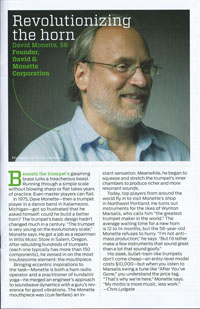"I was the first one up on the first night of the two night event. Most of the honorees were interviewed, but they asked me if I would prefer to give a presentation since I have given similar talks before and they are usually well received. I had about 15 minutes of verbal presentation with 65 graphics and some playing demonstrations on a large screen for the audience to view while I spoke. Then ANDY GRAVISH demonstrated Art Farmer's decorated presentation FLUMPET for a few tunes with the Gary Hobbs Trio. The band was swingin' like mad and the audience loved it. We finished up some Q and A, and then left the event early to take Andy to the airport so he could catch the red eye back to NYC. This was a great time and fun presentation to give. Andy playing with the rhythm section capped it off in fine style, demonstrating the results of the inspiration Art gave me when I invented the FLUMPET."
 Revolutionizing the horn
Revolutionizing the horn
Beneath the trumpet's gleaming brass lurks a treacherous beast. Running through a simple scale without blowing sharp or flat takes years of practice. Even master players can fail.
In 1975, Dave Monette - then a trumpet player in a dance band in Kalamazoo, Michigan - got so frustrated that he asked himself: could he build a better horn? The trumpet's basic design hadn't changed much in a century. "The trumpet is very young on the evolutionary scale," Monette says. He got a job as a repairman in Wills Music Store in Salem, Oregon. After rebuilding hundreds of trumpets (each one typically has more than 150 components), he zeroed in on the most troublesome element: the mouthpiece.
Bringing eccentric inspirations to the task - Monette is both a ham radio operator and a practitioner of kudalini yoga - he merged an engineer's approach to soundwave dynamics with a guru's reverence for good vibrations. The Monette mouthpiece was (cue fanfare) an instant sensation. Meanwhile, he began to squeeze and stretch the trumpet's inner chambers to produce richer and more resonant sounds.
Today, top players from around the world fly in to visit Monette's shop in Northeast Portland. He turns out instruments for the likes of Wynton Marsalis, who calls him "the greatest trumpet maker in the world." The average waiting time for a new horn is 12 to 14 months, but the 56-year-old Monette refuses to hurry. "I'm not anti-mass production," he says. "But I'd rather make a few instruments that sound great than a lot that sound goofy."
His sleek, bullet-train-like trumpets don't come cheap - an entry-level model costs $10,000 - but when you listen to Marsalis swing a tune like "After You've Gone," you understand the price tag. "That's why we're here," Monette says. "My motto is more music, less work."
-Chris Lydgate





